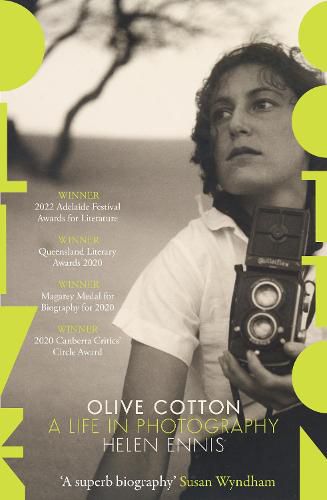Readings Newsletter
Become a Readings Member to make your shopping experience even easier.
Sign in or sign up for free!
You’re not far away from qualifying for FREE standard shipping within Australia
You’ve qualified for FREE standard shipping within Australia
The cart is loading…






Olive Cotton was one of Australia's pioneering modernist photographers, whose significant talent was recognised as equal to her first husband, the famous photographer Max Dupain. Together, Olive and Max were an Australian version of Frida Kahlo and Diego Rivera or Ray and Charles Eames, and the photographic work they produced in the 1930s and early 1940s was bold, distinctive and quintessentially Australian.
But in the mid-1940s Olive divorced Max, leaving Sydney to live with her second husband, Ross McInerney, and raise their two children in a tent on a farm near Cowra - later moving to a cottage that had no running water, electricity or telephone for many years. Famously quiet, yet stubbornly determined, Olive continued her photography despite these challenges and the lack of a dark room. But away from the public eye, her work was almost forgotten until a landmark exhibition in Sydney in 1985 shot her back to fame, followed by a major retrospective at the Art Gallery of New South Wales in 2000, ensuring her reputation as one of the country's greatest photographers.
Intriguing, moving and powerful, this is Olive's story, but it is also a compelling story of women and creativity - and about what it means for an artist to try to balance the competing demands of their art, work, marriage, children and family.
$9.00 standard shipping within Australia
FREE standard shipping within Australia for orders over $100.00
Express & International shipping calculated at checkout
Olive Cotton was one of Australia's pioneering modernist photographers, whose significant talent was recognised as equal to her first husband, the famous photographer Max Dupain. Together, Olive and Max were an Australian version of Frida Kahlo and Diego Rivera or Ray and Charles Eames, and the photographic work they produced in the 1930s and early 1940s was bold, distinctive and quintessentially Australian.
But in the mid-1940s Olive divorced Max, leaving Sydney to live with her second husband, Ross McInerney, and raise their two children in a tent on a farm near Cowra - later moving to a cottage that had no running water, electricity or telephone for many years. Famously quiet, yet stubbornly determined, Olive continued her photography despite these challenges and the lack of a dark room. But away from the public eye, her work was almost forgotten until a landmark exhibition in Sydney in 1985 shot her back to fame, followed by a major retrospective at the Art Gallery of New South Wales in 2000, ensuring her reputation as one of the country's greatest photographers.
Intriguing, moving and powerful, this is Olive's story, but it is also a compelling story of women and creativity - and about what it means for an artist to try to balance the competing demands of their art, work, marriage, children and family.
Discover our favourite photography books, from the work of international icons to archives of Melbourne's sprawling suburbs.
Explore these insightful works of biography and memoir, curated and recommended by Readings staff.